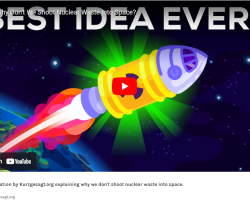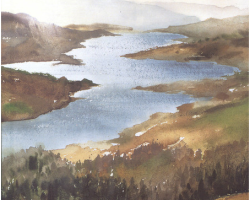Category of Content
Siting Experience Documents Only
Publication Date
Subject Matter
Community Involvement Plan: Area IV, Santa Susana Field Laboratory
Community Involvement Plan: Area IV, Santa Susana Field Laboratory
As a result of the 2007 ruling by the U.S. District Court of Northern California that the DOE must prepare an Environmental Impact Statement (EIS) to evaluate alternatives for cleanup of Area IV of the SSFL, DOE has implemented major changes in its management of SSFL Area IV. As an initial step, this community involvement plan (CIP) outlines a series of activities and programs that intend to engage the public, establish transparency in DOE actions and decisions, and increase input from the community.
Topical Analysis of Nuclear Experts' Perceptions of Publics, Nuclear Energy, and Sustainable Futures
Topical Analysis of Nuclear Experts' Perceptions of Publics, Nuclear Energy, and Sustainable Futures
Nuclear energy experts consider commercial power from fission to be a strong contender to help mitigate the increasing effects of climate change, in part due to its low-to-no carbon emissions. Nevertheless, nuclear energy's history, including meltdowns such as Three Mile Island, Chernobyl, and Fukushima, and dumping in sacred Indigenous land such as Yucca Mountain, raises important concerns in public deliberation over nuclear power.
Nuclear power and the public: an update of collected research on nuclear power
Nuclear power and the public: an update of collected research on nuclear power
The purpose of this research was to collect, analyze, and summarize all of the nuclear power-related surveys conducted in the United States through June, 1981, that we could obtain. The surveys collected were national, statewide, and areawide in scope. Slightly over 100 surveys were collected for an earlier, similar effort carried out in 1977. About 130 new surveys were added to the earlier survey data. Thus, about 230 surveys were screened for inclusion in this report.
Science based responses to social myths on nuclear energy
Science based responses to social myths on nuclear energy
In order to promote a sound basis for considering the role of nuclear in climate change, this review spans the technical topics of social and political debate surrounding nuclear energy with a focus on the objective science of these issues including nuclear waste, accidents and overall risk. Novel aspects include the emergence of nuclear energy as being potentially renewable and the antithesis of Fukushima being an argument for the unacceptable risks associated with the use of nuclear energy.
Survey of National Programs for Managing High-Level Radioactive Waste and Spent Nuclear Fuel: 2022 Update
Survey of National Programs for Managing High-Level Radioactive Waste and Spent Nuclear Fuel: 2022 Update
In October 2009, the U.S. Nuclear Waste Technical Review Board (Board or NWTRB) published Survey of National Programs for Managing High-Level Radioactive Waste and Spent Nuclear Fuel. For each of the 13 national programs studied, the report catalogued 15 institutional arrangements that had been set in place and 15 technical approaches that had been taken to design repository systems for the long-term management of high-activity radioactive waste.
Summary of Consolidated Interim Storage Advantages and Disadvantages from an Integrated Systems Perspective from Prior Reports and Studies
Summary of Consolidated Interim Storage Advantages and Disadvantages from an Integrated Systems Perspective from Prior Reports and Studies
The question of whether centralized storage of civilian spent nuclear fuel (SNF) should be part of the federal waste management system as an intermediate step before permanent disposal has been debated for more than four decades. Centralized storage facilities were included as a potential component of the U.S. spent fuel management system in the Nuclear Waste Policy Act of 1982 (NWPA), but the NWPA did not identify these facilities as being essential.
3 Reasons Why We Don’t Launch Nuclear Waste into Space
3 Reasons Why We Don’t Launch Nuclear Waste into Space
A viral YouTube video recently discussed the age-old question “why don’t we shoot nuclear waste into space?”
It’s a topic we often get asked about on social media.
While the educational video’s cartoonish depictions of nuclear waste as glowing green ooze made some of our subject matter experts cringe, it’s clear that the content creators did their homework.
Status and Trends in Spent Fuel and Radioactive Waste Management
Status and Trends in Spent Fuel and Radioactive Waste Management
Status and Trends in Spent Fuel and Radioactive Waste Management is a collaborative project between the IAEA, the European Commission and the OECD Nuclear Energy Agency, with the participation of nuclear industry organization the World Nuclear Association, that aims to consolidate and complement the information gathered from different initiatives around the world.
Disposition of High-Level Waste and Spent Nuclear Fuel: The Continuing Societal and Technical Challenges
Disposition of High-Level Waste and Spent Nuclear Fuel: The Continuing Societal and Technical Challenges
There has been, for decades, a worldwide consensus in the nuclear technical community for disposal through geological isolation of high-level waste (HLW), including spent nuclear fuel (SNF). However, none of the national programs established to implement geological disposal has yet succeeded in establishing a geological repository and emplacing HLW in it. The large and growing HLW inventory from civilian and military reactor use over nearly 60 years remains in surface facilities intended only for interim storage.





